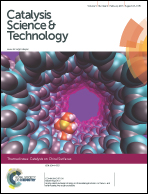Comparative studies on the catalytic activity and structure of a Cu-MOF and its precursor for alcoholysis of cyclohexene oxide
Abstract
The wide use of metal–organic frameworks (MOFs) in heterogeneous catalysis has been limited due to the fact that the coordination sphere of the metal ions in most known MOF structures is completely blocked by the organic linkers. In this work, a comparative structural study of the precursor Cu(BF4)2·nH2O (active metal salt catalyst) and the derived Cu-MOF was carried out by using solid-state nuclear magnetic resonance (NMR) and electron paramagnetic resonance (EPR) techniques combined with the study of the interaction of the materials with different reactant molecules by thermogravimetry coupled with mass spectrometry (TG-MS). We clarify how an ideal MOF catalyst can keep the same high reactivity as its metal precursor, and how the existing efficient metal salt/complex catalysts can be linked to analogously reactive MOF catalysts. By choosing proper precursors and organic linkers, MOFs can keep an unsaturated and flexible coordination sphere, which endows them with unique guest-induced reactivity and reactant shape selectivity. The labile coordination facilitates MOFs to perform as well as metal complexes in alcoholysis of cyclohexene oxide but affording good recyclability.


 Please wait while we load your content...
Please wait while we load your content...